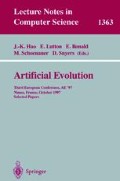Abstract
The use of heuristics such as Genetic Algorithm optimisation methods is appealing in a large range of inverse problems. The problem presented here deals with the mathematical analysis of sequences generated by finite automata. There is no known general exact method for solving the associated inverse problem. GA optimisation techniques can provide useful results, even in the very particular area of mathematical analysis. This paper presents the results we have obtained on the inverse problem for fixed point automata. Software implementation has been developed with the help of “ALGON”, our home-made Genetic Algorithm software.
Preview
Unable to display preview. Download preview PDF.
References
J.-P. Allouche, T. Johnson (1995): Finite automata and morphisms in assisted musical composition. Journal of New Music Research 24, 97–108.
J. E. Baker (1987): Reducing bias and inefficiency in the selection algorithm. Genetic Algorithms and their application: Proceedings of the Second International Conference on Genetic Algorithms, p. 14–21.
A. Cobham (1972): Uniform tag sequences. Math. Systems Theory 6, 164–192.
S. Eilenberg (1974): Automata, Languages, and Machines. Vol. A, Academic Press.
F. Durand (1997): A characterization of substitutive sequences using return words. Disc. Math., to appear.
B. Leblanc, E. Lutton (1997): ALGON: A Genetic Algorithm software package, http://www-rocq.inria.fr/fractales/
J.-P. Allouche (1996): Transcendence of the Carlitz-Goss Gamma function at rational arguments. J. Number Theory 60, 318–328.
J.-P. Allouche, J. Currie, J. Shallit (1997): Extremal infinite overlap-free binary words. Preprint.
V. Berthé (1994): Automates et valeurs de transcendance du logarithme de Carlitz. Acta Arith. 66, 369–390.
G. Christol (1979): Ensembles presque périodiques k-reconnaissables. Theoret. Comput. Sci. 9, 141–145.
G. Christol, T. Kamae, M. Mendés France, G. Rauzy (1980): Suites algé briques, automates et substitutions. Bull. Soc. Math. France 108, 401–419.
M. Mendès France, J.-y. Yao (1997): Transcendence and the Carlitz-Goss gamma function. J. Number Theory 63, 396–402.
Author information
Authors and Affiliations
Editor information
Rights and permissions
Copyright information
© 1998 Springer-Verlag Berlin Heidelberg
About this paper
Cite this paper
Leblanc, B., Lutton, E., Allouche, J.P. (1998). Inverse problems for finite automata: A solution based on genetic algorithms. In: Hao, JK., Lutton, E., Ronald, E., Schoenauer, M., Snyers, D. (eds) Artificial Evolution. AE 1997. Lecture Notes in Computer Science, vol 1363. Springer, Berlin, Heidelberg. https://doi.org/10.1007/BFb0026598
Download citation
DOI: https://doi.org/10.1007/BFb0026598
Published:
Publisher Name: Springer, Berlin, Heidelberg
Print ISBN: 978-3-540-64169-8
Online ISBN: 978-3-540-69698-8
eBook Packages: Springer Book Archive

